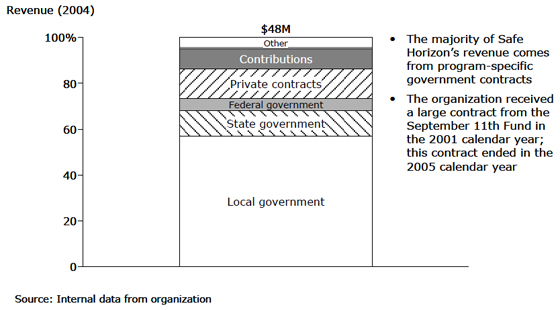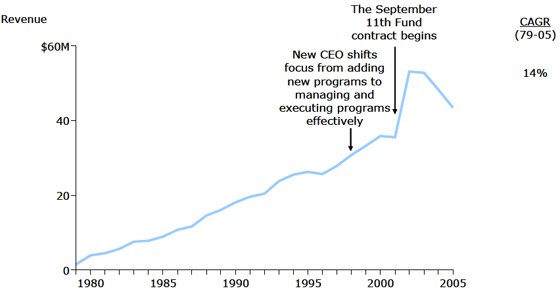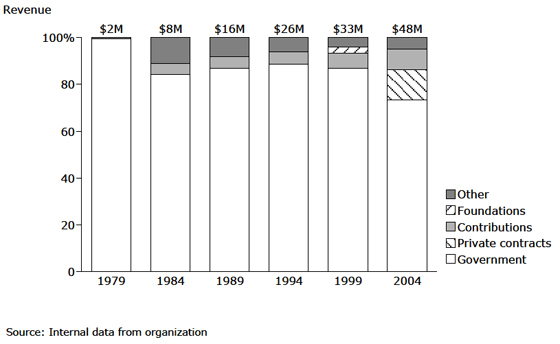We are a social service agency, but we are also a business. The ability to manage and plan effectively, together with maintaining the quality of our social services, has allowed us to be successful in an increasingly competitive market.
– Gordon Campbell, Chief Executive Officer
Overview
Related Content
How Nonprofits Get Really BigOrganization Profiles from How Nonprofits Get Really Big
For over a quarter of a century, Safe Horizon has been at the forefront of helping victims of crime and abuse through their crises. In the greater New York City area, the organization annually serves 350,000 individuals who have experienced emotional or physical trauma resulting from victimization. Safe Horizon (formerly named Victim Services) began as a research-oriented pilot project of the Vera Institute of Justice, serving victimized witnesses in New York City’s criminal justice system. Now it is the largest victim service agency in the nation.
Safe Horizon has added programs in response to client needs and funding opportunities. It now runs 80 programs, which vary from domestic violence shelters to court-based services for victims. A central office provides administrative and management support and strategic direction across all the programs, while the programs themselves maintain autonomy for daily operations.
The majority of Safe Horizon’s funding has come from city agencies disbursing a variety of local, state, and federal funds. The organization expanded quickly immediately following the 9/11 tragedies in 2001, primarily due to the receipt of a large contract from the September 11th Fund. Safe Horizon spread that funding over a five-year period, to provide services to meet the ongoing needs of those directly impacted by the events of 9/11.
Founding date: 1978
Revenue (2004): $48 million ($53 million in 2003)
Structure: Single organization
NCCS classification: Human Services—Victim Services
Services: Provides support, prevents violence, and promotes justice through direct service and advocacy
Beneficiaries: Victims of crime and abuse, their families, and their communities
Leadership (selected): Gordon Campbell, Chief Executive Officer; Bea Hanson, Chief Program Officer; Scott Millstein, Chief Operating Officer
Address: 2 Lafayette St., 3rd Floor, New York, NY 10007
Website: www.safehorizon.org

Growth Story
- 1975 – The Vera Institute of Justice pilots a program for serving New York City criminal court witnesses who have been intimidated or feel under threat. The program improves witness’ trial attendance by more than 40%.
- 1975 - 1978 – The program expands throughout NYC’s criminal justice system. It becomes a stand-alone organization named Victims’ Services in 1978 after receiving a major contract from Mayor Ed Koch.
- 1978 - 1984 – Victim Services creates new programs primarily within the criminal and civil justice systems.
- 1984 - 1988 – The organization expands its programming for victims outside of NYC’s justice system, including school-based violence prevention, community-based victim counseling, and support and shelter for domestic violence victims.
- 1988 - 1996 – Victim Services starts serving immigrants as well as physically and sexually-abused children and their families. It also begins to offer legal aid services.
- 1998 – New CEO Gordon Campbell emphasizes strategic, mission-based program development and execution as well as effective management.
- 2000 – Victim Services undergoes a strategic planning process, during which it decides to transition to other agencies programs that do not fit with its core mission; to increase IT, facilities, and systems infrastructure; and to implement strict budgeting discipline. The organization changes its name to Safe Horizon. Its new leadership continues to focus its programs and to create synergies among them.
- 2001 - 2002 – Safe Horizon expands rapidly to serve the victims of the 9/11 tragedies. It grows its staff from 600 to 1,000.
- 2003 - 2004 – Safe Horizon’s leadership works to avoid a major dip in revenue post-9/11 by increasing funding from other existing sources.
- 2006 – The organization spends the last of its 9/11-related funds. Its staff size stabilizes at approximately 700 members.
Revenue Trends
Revenue growth: Safe Horizon sustained revenue growth by expanding its program offering and contracting with new agencies.

Funding mix: Other than the appearance of 9/11-related funding, Safe Horizon’s funding has consistently relied on government funds.

Actions That Helped Propel Growth in Funding
- Ran the organization like a business. CEO Gordon Campbell noted that, “We are a social service agency, but we are a business as well.” Setting and adhering to long term goals, implementing systems, and adding expertise through key hires have increased the organization’s effectiveness and financial stability.
- Documented its results. The documented results of the Vera pilot project spurred Safe Horizon’s creation. Measurement has remained central to the organization’s success, with its ability to provide data that meet city and local reporting standards and to demonstrate results helping the organization to secure new contracts and renew existing ones.
- Pioneered an idea and supported it with an ongoing focus on quality. The organization came to be by serving a previously unserved group of victims with a pioneering model. As other agencies began catering to the same need, the organization began focusing intensively on program quality to maintain a strong position, while nurturing collaborative relationships with key government funders.
Funding Challenges
- Saying “no” to non-core programs. Over the years Safe Horizon took on multiple contracts for programs that did not fit tightly with its goals. It transitioned some programs to other agencies during its realignment in 2000, to allow the organization to focus on its core impact.
- Scaling up and down rapidly in response to 9/11. The rapid expansion and slow reduction in programs related to 9/11 tested Safe Horizon’s ability to manage rapid growth and contraction.
- Dealing with numerous city agencies. CEO Campbell notes that dealing with several different city agencies vastly complicates the organization’s central management function, giving rise to varied contract structures and reporting requirements.

